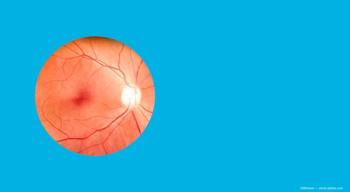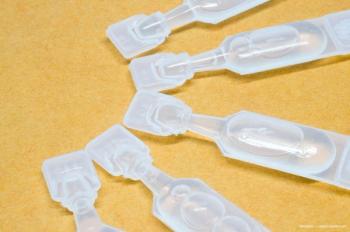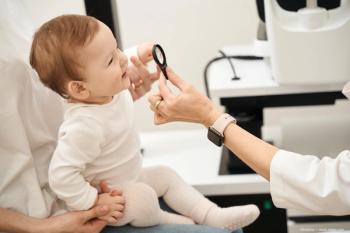
What clinicians should know about ocular allergies
The arrival of spring also signals the onset of ocular allergy season. Clinicians can prepare by knowing and recognizing the symptoms in their patients, as well as being informed about the latest therapies for this diagnosis.
Allergy season is upon us, and soon patients will be looking for solutions to their red and itchy eyes. Let's brush up on how to recognize these patients with ocular allergies, how to confirm their diagnosis, and how best to manage what is beneath the surface of these troubled seas.
Differential diagnosis
Patient with a known history
of allergic conjunctivitis 15 to 20 minutes after conjunctival allergan challenge (Ora-CAC).
(Image courtesy of Ora Inc.)
An ocular allergy diagnosis is old fashioned and no frills. No high-powered kits, tear samplings, biomarkers, or other expensive accoutrements are needed for confirmation of allergic conjunctivitis.
Related:
The foremost symptom of itching must be present as it is pathognomonic for this disease. Rarely do we find one symptom that is necessary and almost exclusive to one disease, and this makes our job as clinicians easier.
Other allergic symptoms-burning, stinging, tearing, and mucous discharge-can all be signs of dry eye, and hyperemia is the red flag of many inflammatory and/or infectious conditions. Still, certain patterns of redness suggest dry eye (horizontal, within the palpebral fissure), meibomian gland dysfunction (MGD) (inferior and lid proximal), or even bacterial (diffuse and severe) or viral (violet red) infection in a way that does not bring to mind allergy.
Eyelid swelling with the watery ballooning of chemosis points the arrow in the direction of allergy; crusting and purulent discharge is clearly bacterial; and profuse tearing with violet red hyperemia is probably viral (but should be explored further).
Recent:
I have seen thousands of allergic eyes, and the telltale heart of allergic redness is the watery shimmer on the chemotic conjunctival bed. Eyelid swelling is also characteristic, as it is more generalized than that seen in MGD or chalazion.
The slit lamp examination is needed more for differential diagnosis and ruling out of other causes of a red and swollen eye. Any corneal involvement indicates either more severe forms of ocular allergy, such as atopic (AKC) or vernal keratoconjunctivitis (VKC), particularly if the patient complains of photophobia.
To view table of drug classes for allergy treatment,
Diagnosis of these inflammatory-allergic diseases would be confirmed by the presence of fibrotic hypertrophy, such as giant papillae or gelatinous limbal infiltrates in younger patients (VKC) or lid eczema and blepharitis in the older patient (AKC).
Toxic reactions to excessive eye-drop use or skin creams and cosmetics can also result in red and swollen eyes. However, the allergic itching will probably be missing.
Allergy or dry eye:
This can occur with ocular decongestant abuse, hypersensitivity reactions to active ingredients, such as antibiotics and beta-blockers, or to inactive ingredients, such as benzalkonium chloride.
Greater involvement of reddening periocular skin is a good indication of drug-induced toxicity rather than allergic conjunctivitis.1
Medical history/available tests
A good medical history will tease out environmental triggers to red and itchy eyes.
Spring allergies are related to tree sensitization; summer to grasses and weeds; and late summer to ragweed-the plant pollen most likely to cause allergic conjunctivitis. If there is no seasonality to symptoms, patients may be allergic to mold, mites, cockroaches, or the family pet.
In the know:
These allergens are most difficult to avoid. If signs and symptoms are worse upon awakening, a mite allergy should be suspected. Skin test or serum IgE test results might be available if the patient has allergies in other tissue sites.
I have always been a proponent of eosinophil scrapings. However, while their presence guarantees an allergic diagnosis, their absence does not preclude allergy. Only 45% of patients with ocular allergies have positive eosinophils in conjunctival scrapings since they are often found deeper in the conjunctiva.2
Therapy
The first defense against allergy is as low-tech as the diagnosis: hygiene. Washing away allergen on and around the eyes, showering, shampooing, and changing clothes after being outside works wonders in helping patients get through allergy season.
Similarly, anti-mite covers on bedding, frequent hot washing of sheets and pillowcases, and ventilation of bedrooms and houses work well in minimizing exposure to mites.
Artificial tears can do the same for diluting allergen and mediators in the eyes before active treatments are even initiated.
Systemic antihistamines should be avoided unless there is allergy in another tissue site, which there often is. Some systemic antihistamines are drying, and dry eye will make the allergic eye worse.3
Recent:
Though clinicians may recommend local treatment for local allergies, because of proximal anatomy, treating rhinitis often ends up with benefits to the eye and treating the eye benefits the nose.
Ophthalmic antihistamines have come a long way from the stinging, burning, short-acting, first-generation compounds, such as antazoline and pheniramine.
There is no reason to look further than alcafatadine (Lastacaft, Allergan) or olopatadine (Pataday, Alcon Laboratories)-which are the only products approved for once-daily dosing. New comparative studies indicate that alcaftadine relieves the intense itching of immediate histamine release better than olopatadine.4
Sixteen hours after dosing, alcaftadine achieved significantly lower mean itching compared with olopatadine 0.2% (0.50 versus 0.87, respectively; p < 0.0006) at the peak time for itching.
Practice Management:
Analysis over all the post-challenge time points measured (3, 5, and 7 minutes) also demonstrated a statistically lower overall mean itching score with alcaftadine compared with olopatadine 0.2% (0.68 versus 0.92; p = 0.0390).
The magnitude of response with regard to itching was also superior with alcaftadine. For all post-CAC time points (3, 5, and 7 minutes), when challenged 16 hours after dosing, 76% of subjects in the alcaftadine group and only 58% of those in the olopatadine group reported minimal itch. This indicated that 16 hours after instilling one drop of medication, more than 75% of all patients in the alcaftadine-treated group reported only a mild, transient itching sensation when challenged with allergen.4
Preclinical studies focused on understanding what makes alcaftadine unique have identified that this drug maintained intact the tight junctions of the conjunctival epithelium, providing means to strengthen defenses against allergen entry.5 Olopatadine did not provide this same benefit.
Future treatment trends
Future trends in allergy are focused on different delivery methods as well as more targeted molecules. Treating chronic allergy and breakthrough symptoms with a slow-release punctal plug of steroid might seem risky, but taking steroid dosing out of the hands of patients and into physicians increases its safety margin by preventing overmedication, the greatest risk of steroid use. Ocular Therapeutix is in phase III development of its depot dexamethasone (Dextensa) for both postoperative inflammation and ocular allergy.
Sometimes patients can get refills for steroid drops, and then overmedicate for weeks or months. These issues go away if the ophthalmologist must insert the new plug, also then ensuring that the patient returns for regular check-ups before replacement.6
Another option is contact lens-eluting medication.7,8 This has already been proposed for glaucoma as a continuous therapy option, and would open up the possibility of lens wear to a population of patients known to be lens-intolerant.
The Syk/Jak kinases-key to the mast cell signaling cascade-are under scrutiny as the next development in allergy therapy.9 Imagine stopping the kinase cascade before it even starts, and that is what researchers are trying to do with Syk and JAK inhibitors.
These compounds are attractive for the treatment of allergic diseases with an inflammatory component, including allergic conjunctivitis, since they target both the early phase of the allergic response-mediated by histamine and other molecules released during mast cell degranulation-and the late-phase response-mediated by mast cell-secreted cytokines that activate TH2 cells and other cells of the immune system.
If successful, Syk inhibitors could effectively act similarly to antihistamines and steroids combined, and with a greatly improved safety profile than corticosteroids. Pfizer and Zanofi are developing products for allergy and asthma, respectively.
When
Recent:
References
1. Abelson MB, Smith LM, Chapin M. Ocular allergic disease: mechanisms, disease sub-types, treatment. The Ocular Surface. 2003;1:38-60.
2. Abelson MB, Madiwale N, Weston JH. Conjunctival eosinophils in allergic ocular disease. Arch Ophthalmol. 1983;101:555-556.
3. Welch D, Ousler GW, Nally LA, Wilcox KA. Ocular drying associated with oral antihistamines (loratadine) in the normal population- an evaluation of exaggerated dose effect. Adv Exp Med Biol. 2002;506:1051-1055.
4. McLaurin EB, Marsico NP, Ackerman SL, et al. Ocular itch relief with alcaftadine 0.25% versus olopatadine 0.2% in allergic conjunctivitis: pooled analysis of two multicenter randomized clinical trials. Adv Ther. 2014;31:1059-1071.
5. Ono SJ, Lane K. Comparison of effects of alcafatadine and olopatadine on conjunctival epithelium and eosinophil recruitment in a murine model of allergic conjunctivitis. Drug Design, Development, and Therapy. 2011;5:77-84.
6. McLaurin EB, Torkildsen GL, Gomes PJ. Sustained-release dexamethasone intracanicular depots for the treatment of allergic conjunctivitis. 2015 American Academy of Ophthalmology Annual Conference, Las Vegas; Cornea and External Disease, Session One, Scientific Poster 57, p 174.
7. Hsu KH, Carbia BE, Plummer C, Chauhan A. Dual drug delivery from vitamin E loaded contact lenses for glaucoma therapy. Eur J Pharm Biopharm. 2015;94:312-321.
8. Ciolino JB, Dohlman CH, Kohane DS. Contact lenses for drug delivery. Seminars in Ophthalmol. 2009;24:156-160.
9. MacGlashan DW. IgE-dependent signaling as a therapeutic target for allergies. Trends in Pharm Sci. 2012;33:502-509.
Newsletter
Don’t miss out—get Ophthalmology Times updates on the latest clinical advancements and expert interviews, straight to your inbox.



















































.png)


